Can social media save the world? Some nonprofits give it a try.
Several efforts are afoot to harness the potential of social media for aid organizations and similar groups. The idea is to efficiently get help to people who need it.

As Facebook shows that 500 million people can connect through a single platform, some aid organizations and similar groups are using the social media to save the world.
facebook.com screengrab
Los Angeles
As Facebook shows that 500 million people can connect through a single platform, one of the most powerful tools in human history is being tapped to – well – save the world, say a growing number of media and technology experts.
More precisely, they say, a rising number of software designers are harnessing social media’s über-connectedness for something other than a million-member chat about whether Lindsay Lohan should serve a full jail term. As local, state and federal budgets swim in red ink, some are hoping that a sophisticated “search and match” software system can help get the available housing, education, health, and job services to the people in need.
“Social networks suit the American character,” says Rita Kirk, a professor of business communication at Southern Methodist University in Dallas. “They permit us to connect with one another, provide aid, counsel, and share resources to solve problems.”
Now, social networks are drawing on the high-tech tools of the 21st century. As more individuals and businesses push into the digital sphere, says Sherrie Madia at the University of Pennsylvania’s Wharton School, “people are feeling empowered by broader connections.” There is a growing trend, she adds, toward “people and corporations looking for a higher purpose.”
Such is the case with the just-launched WE Movement, an offshoot of the Ramsell corporation in Oakland, Calif. The company had developed a sophisticated search-and-match software for healthcare services and providers, but it wanted to broaden its work. “We wanted to go back to the way things were decades ago when people helped people, neighbors looked out for each other,” says chief operating officer Tom Loker, WE Movement’s founder. Government, he says, is not the solution.
Marsha Martin, director of Get Screened Oakland, which deals with HIV issues, is one of what the WE organization is calling “WE Champions” –grass-roots organizers who spread the word. Groups such as hers are losing up to 80 percent of their funding in the current California budget crisis. With the search-and-match tools of WE’s software, which is provided for free, she may be able to recoup as much as half that loss, she says. That could happen through more efficiency and more connections with donors and other sponsors.
“Google and Facebook connected millions of people to find their friends and other stuff. Now it’s time for social services to get the same support,” Ms. Martin says. WE’s program is helping her to locate those in need and find distant and disparate sources of services for them – including housing, medications, and education.
Her biggest obstacle, she says, are the archaic or sometimes nonexistent computer systems of many agencies and individuals with whom she hopes to interface. To work on such issues, the WE Movement is debuting its tool initially as a pilot program in Oakland. There, the organization aims to work out issues ranging from privacy concerns to technology capacity. Martin’s sponsors, which include Chevron and Levi Strauss, are watching closely.
On the other coast, in McLean, Va., Small Act – whose motto is to “make a big impact in social media” – just released Thrive, a new social-networking tool designed to help nonprofits connect with resources and recipients. The company, says CEO Casey Golden, grew from a desire to put technology to better use.
Mr. Golden says he and his wife were discussing the power of a single penny a day put aside for philanthropy. One penny doesn’t amount to much, but multiply that by millions, and it does. “Small acts,” he says, can have a big impact if they are done by enough people.
The trend is only going to continue, he maintains: In 2008, he says, social media was about investigating the space, and in 2009, the emphasis was on having a presence. Now, the focus is on measuring social media’s power, and next year, he suggests, “will be about getting results.”
